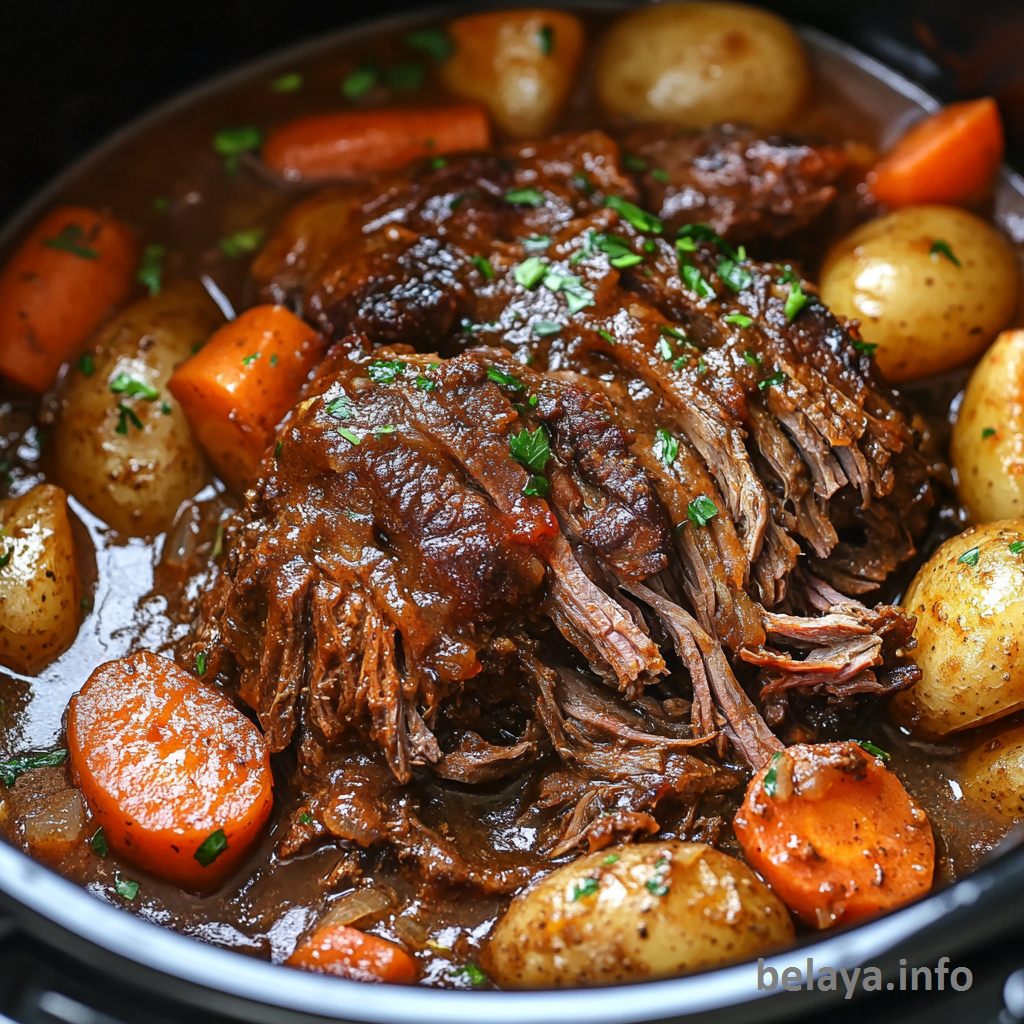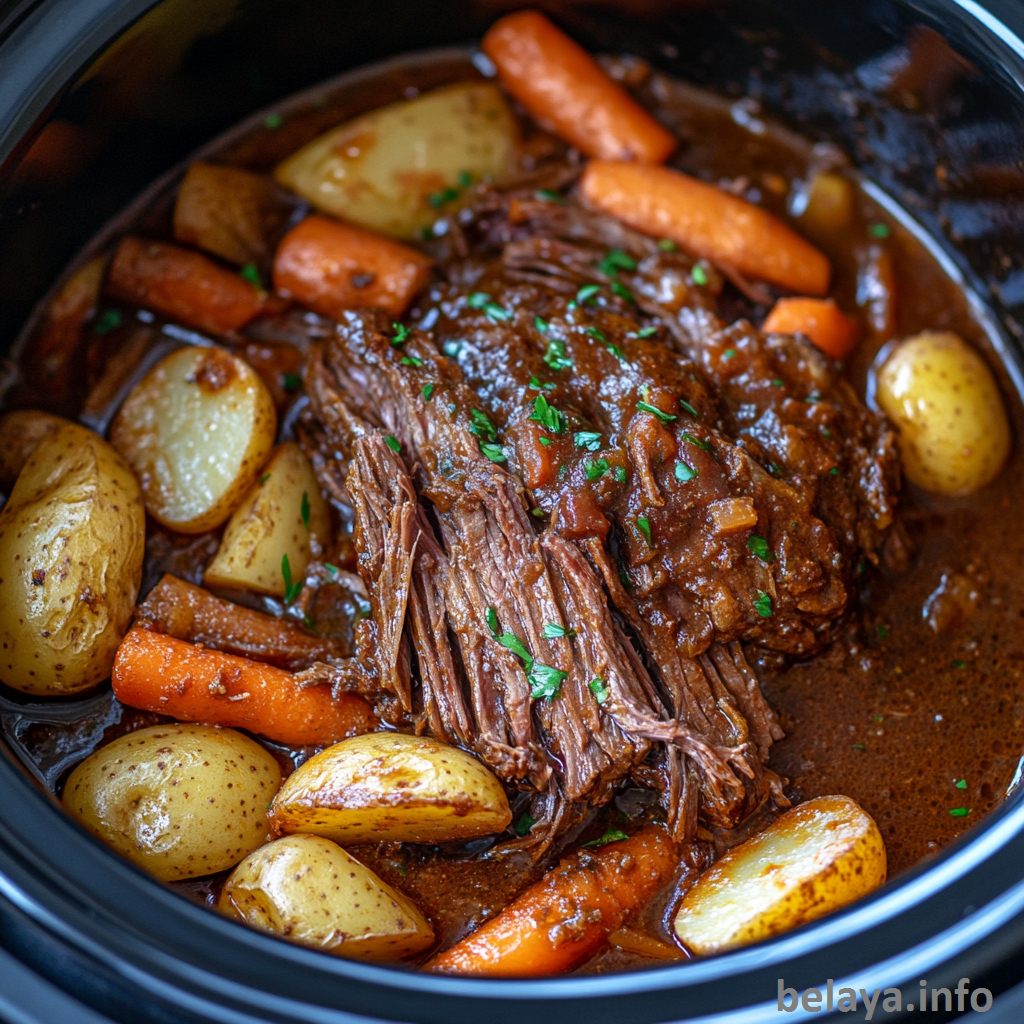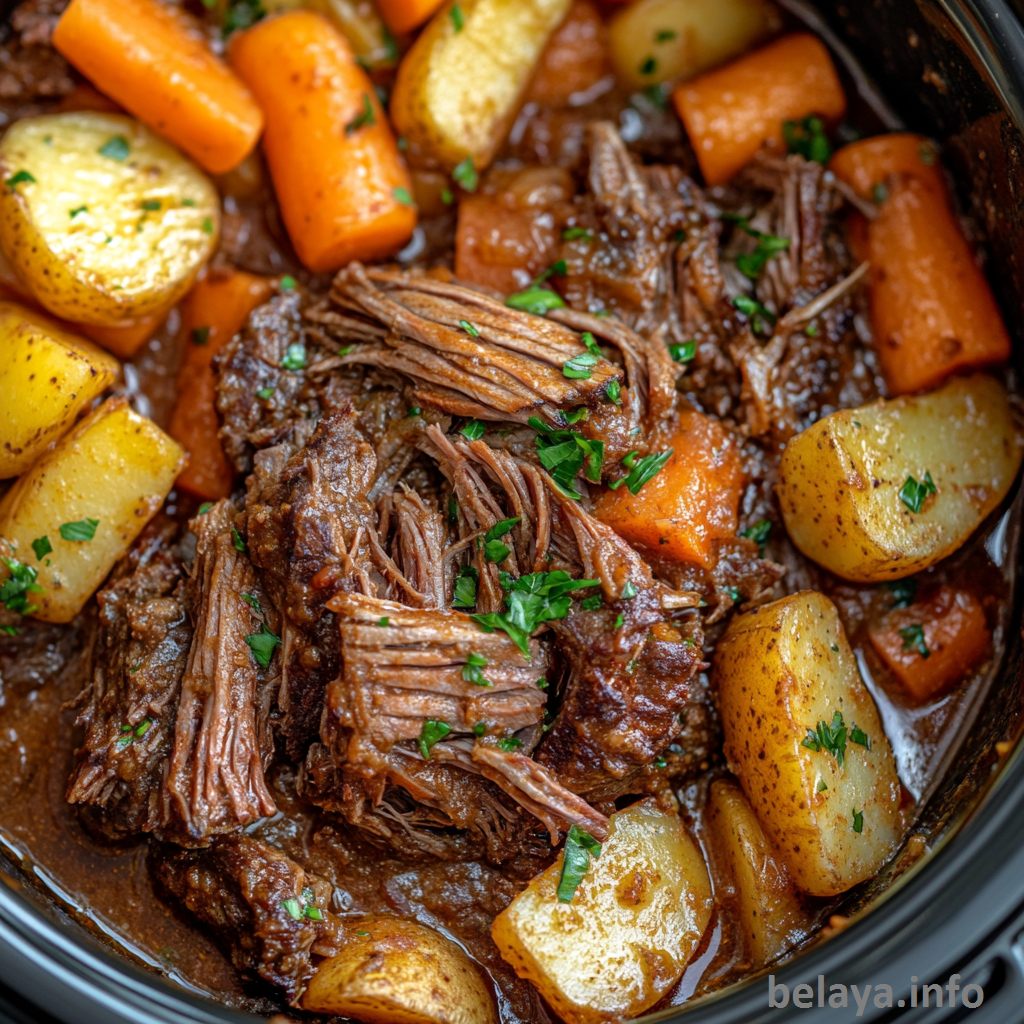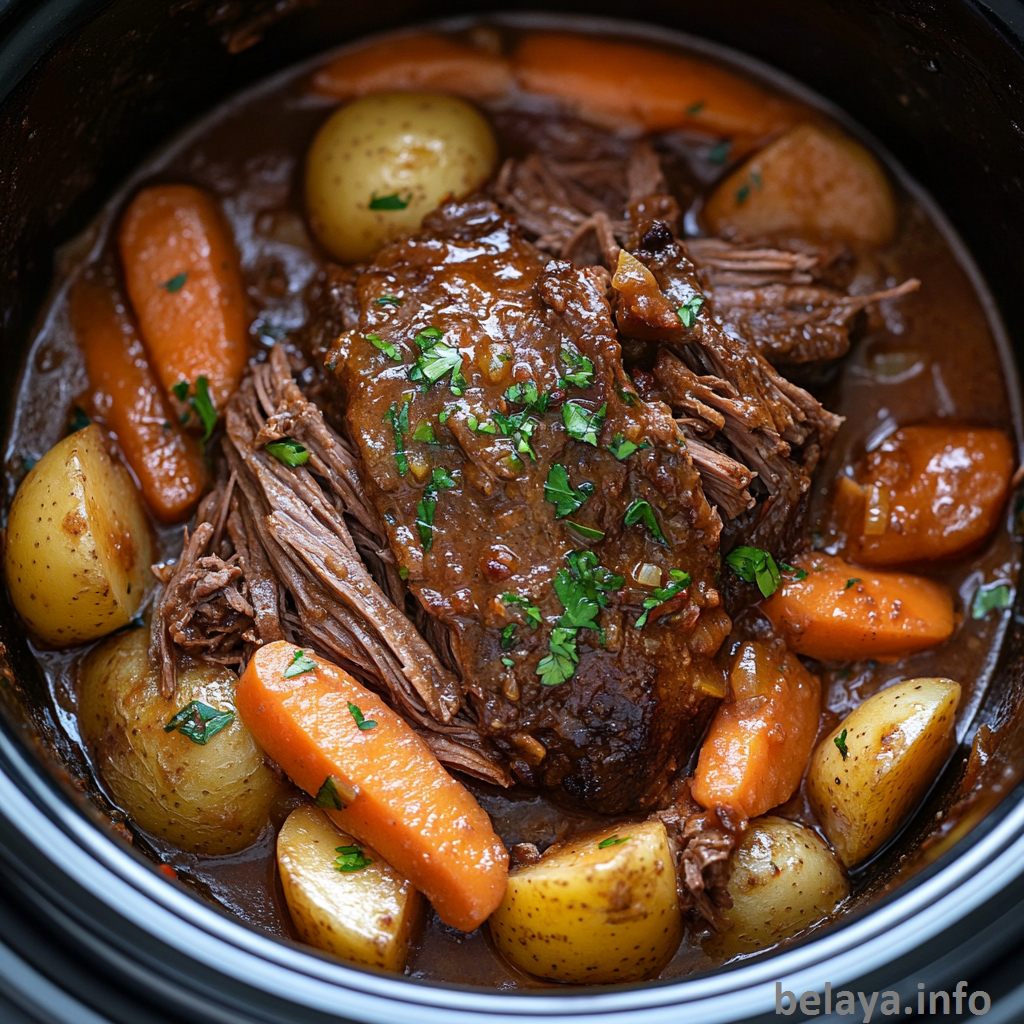Italian Pot Roast (Stracotto)
Stracotto, meaning “overcooked” in Italian, is anything but ordinary. This Italian Pot Roast (Stracotto) is the soulful centerpiece of Italian comfort cooking—a slow-braised beef pot roast, simmered for hours until meltingly tender, soaked in a rich tomato and herb-infused broth.
Layered with aromatic vegetables, crispy bacon, and the warmth of rosemary and thyme, this is a recipe built on time, patience, and tradition.
Whether served over creamy polenta, buttered noodles, or rustic mashed potatoes, each bite is a reminder that sometimes, the most memorable meals are the ones that ask you to slow down and savor.

Why People Will Love Italian Pot Roast (Stracotto) Recipe:
Deeply comforting and soul-satisfying:
Slow-cooked for hours, the beef becomes incredibly tender—almost spoon-soft—infused with a rich, savory broth that feels like a warm embrace in every bite.
Aromatics that build layers of flavor:
Onion, carrot, celery, garlic, and herbs meld into a deeply flavorful base, transforming simple ingredients into something truly luxurious over time.
Timeless Italian tradition in every pot:
Stracotto brings rustic Italian cooking into your home kitchen—honoring old-world techniques with ingredients that speak to both heritage and heart.
Versatile and crowd-pleasing:
Whether served over polenta, pasta, mashed potatoes, or crusty bread, this dish adapts to any occasion—casual family dinners or elegant entertaining alike.
Set-it-and-forget-it ease:
Despite its richness, the recipe is incredibly flexible—whether on the stove, in the oven, or in a slow cooker, it gives maximum reward with minimal effort.
Even better the next day:
Like many braised dishes, the flavor deepens overnight, making leftovers (if there are any) something to truly look forward to.

Key Ingredients:
Beef Chuck Roast:
This cut is rich in connective tissue and marbling, which breaks down beautifully during slow cooking, yielding fork-tender meat that absorbs every layer of flavor from the braising liquid.
Bacon or Pancetta (Optional but Impactful):
Rendered at the start, it forms a flavorful fat base that adds smokiness, depth, and a subtle savoriness that lingers throughout the dish.
Aromatic Trinity (Onion, Carrot, Celery):
This classic soffritto forms the heart of Italian flavor foundations. Gently sautéed, they sweeten and soften, building a rich, vegetal backbone to the sauce.
Garlic and Red Pepper Flakes:
Garlic infuses warmth and depth, while a pinch of chili adds just enough heat to round out the richness without overwhelming the palate.
Crushed Tomatoes & Beef Broth:
This duo creates a robust braising liquid—savory, tangy, and hearty—thickening slowly into a luxurious sauce that clings to every shred of beef.
Fresh Herbs (Rosemary, Thyme, Bay Leaf):
These aromatics infuse the stew with earthy, herbal complexity. As they simmer, their essential oils release slowly, elevating the broth with layered, rustic elegance.
Italian Seasoning Blend:
A balanced mix of dried herbs that ties the dish together with familiar, comforting notes—oregano, basil, marjoram—all working in quiet harmony.

Expert Tips:
Choose the right cut of beef:
Use well-marbled cuts like chuck roast or brisket. These cuts have enough fat and connective tissue to break down during slow cooking, turning tough meat into fork-tender strands that soak up the sauce beautifully.
Brown the meat deeply for complex flavor:
Take your time when searing the beef—don’t rush this step. A deep golden crust adds layers of umami to the final dish and builds fond (caramelized bits) in the pot that dissolve into the sauce as it simmers.
Sauté aromatics slowly for a richer base:
Onion, carrot, and celery should be cooked until soft and slightly golden. This slow sautéing releases natural sugars and creates a flavorful foundation before deglazing with broth and tomatoes.
Use whole herb sprigs when possible:
Fresh thyme and rosemary can be added whole and removed later. This gives you intense herbal flavor without flecks of overpowering dried herbs in the final dish.
Simmer gently and patiently:
Whether using the stovetop, oven, or slow cooker, keep the temperature low and steady. A gentle simmer (not a boil) ensures the meat becomes tender without drying out.
Make it ahead for even better flavor:
Like most braised dishes, Stracotto improves with time. Prepare it a day in advance, let it cool, then reheat gently. The rest allows the meat to soak up even more of the aromatic tomato broth.
Skim fat before serving for balance:
If the dish sits overnight, fat will rise and solidify—making it easy to remove before reheating. This results in a cleaner, more refined broth without sacrificing richness.

Italian Pot Roast (Stracotto)
Ingredients
4 ounces bacon (or pancetta), diced (optional)
3 pounds beef (such as chuck), cut into 3 large pieces
Salt and pepper to taste
1 cup onion, diced
1 cup carrot, diced
1 cup celery, diced
1 tablespoon garlic, chopped
1/2 teaspoon red pepper flakes (optional)
2 cups beef broth
1 (14.5 ounce) can crushed tomatoes
1 sprig thyme (or 1 teaspoon fresh chopped or 1/2 teaspoon dried)
1 sprig rosemary (or 1 teaspoon fresh chopped or 1/2 teaspoon dried)
1 teaspoon Italian seasoning
2 bay leaves
Salt and pepper to taste
Instructions:
Step 1:
Cook the bacon in a large, oven-safe pot (like a Dutch oven) over medium heat, then remove and set aside.
Step 2:
Season the beef with salt and pepper. Brown the beef in the bacon grease over medium-high heat, then remove and set aside.
Step 3:
Add the onion, carrot, and celery to the pot and cook until tender, about 7-10 minutes.
Step 4:
Add the garlic and red pepper flakes, cooking for about a minute until fragrant.
Step 5:
Pour in the beef broth, crushed tomatoes, thyme, rosemary, Italian seasoning, bay leaves, and the cooked bacon. Stir to combine before adding the beef back into the pot.
Step 6: You can choose one of the following methods:
- (1) Bring to a boil, reduce the heat to low, and simmer covered until the beef is tender, about 2-4 hours.
- (2) Cover and transfer to a preheated oven at 275°F (140°C) and cook until the beef is tender, about 2-4 hours.
- (3) Transfer to a slow cooker and cook on low for 8-10 hours or on high for 4-6 hours.
Step 7: Once done, season with salt and pepper to taste. Remove the sprigs of thyme, rosemary, and bay leaves, and enjoy!

Important Notes When Making Italian Pot Roast (Stracotto):
Low and slow is non-negotiable:
The magic of Stracotto lies in time. Whether on the stovetop, in the oven, or a slow cooker, the beef needs several hours of gentle braising to become truly tender and infused with flavor. Rushing the cook time will result in tough meat and a thin, underdeveloped sauce.
Let the beef rest in its juices after cooking:
Once the roast is done, allow it to rest in the sauce for 15–20 minutes before serving or shredding. This helps redistribute moisture and allows the fibers to relax, ensuring juicy, flavorful meat.
Don’t overcrowd during searing:
Sear the beef in batches if necessary. Overcrowding lowers the pan temperature and leads to steaming rather than browning, which reduces the depth of flavor in your base.
Use good-quality broth and tomatoes:
Because the recipe relies on a long simmer, the quality of your liquid ingredients matters. Use low-sodium broth to better control salt levels, and choose crushed tomatoes with a rich, sweet flavor.
Salt strategically, not heavily:
With bacon, broth, and seasoning already in the pot, be cautious with salt. Taste and adjust at the end once the sauce has reduced and concentrated.
Strain or puree for a refined sauce (optional):
For a smoother, restaurant-style finish, strain the sauce or blend it after removing the meat and herbs. This creates a velvety, deeply flavorful reduction to serve over pasta, polenta, or mashed potatoes.
Great for next-day meals or freezing:
This dish holds exceptionally well and even improves after resting overnight. It also freezes beautifully—just portion it with sauce and reheat gently for a quick, comforting meal anytime.

How to Enjoy Italian Pot Roast (Stracotto) After Cooking
Let It Rest Before Serving
After the pot roast finishes cooking, don’t serve it right away. Let the beef rest in its braising liquid, covered, for 15–20 minutes. This allows the juices to redistribute into the meat, keeping it moist and flavorful. It also gives the sauce time to settle and intensify.
Shred or Slice for Maximum Comfort
Stracotto is traditionally served shredded or gently pulled apart into chunks. This allows the beef to soak up more of the sauce, giving you rich flavor in every bite. Alternatively, if you prefer a more formal presentation, slice it against the grain while warm.
Serve Over the Right Base
Pair the beef and its tomato-herb sauce with something that soaks it up beautifully:
Creamy polenta – A classic Italian pairing that balances richness with softness.
Buttered pappardelle or tagliatelle – Wide noodles hold the sauce well and add hearty satisfaction.
Mashed potatoes – Rustic and comforting, perfect for absorbing every drop of the sauce.
Crusty bread – Use to mop up the juices for a simple but unforgettable experience.
Finish with Freshness
Just before serving, add a final touch to elevate the dish:
Chopped fresh parsley or basil for brightness.
A drizzle of good olive oil for gloss and richness.
A splash of lemon juice (if desired) to cut through the depth with gentle acidity.
Pair with a Bold Red Wine
A dish this rich deserves a wine that stands up to it:
Chianti Classico, Barolo, or Montepulciano are traditional Italian pairings.
For something more casual, try a Cabernet Sauvignon or Zinfandel.
For non-alcoholic options, sparkling water with lemon or a robust black tea works well to cleanse the palate.
Savor Slowly, Share Generously
Stracotto is a dish rooted in community and patience. Serve it family-style in a large dish at the center of the table. Invite conversation. Let guests help themselves. This is comfort food meant to be shared, not rushed.

Nutrition Information:
Per serving for Italian Pot Roast (Stracotto), assuming the recipe yields 6 servings and includes bacon and all listed ingredients:
Calories: 435 kcal | Total Fat: 25.6 g | Saturated Fat: 9.2 g | Monounsaturated Fat: 12.1 g | Polyunsaturated Fat: 1.5 g | Cholesterol: 125 mg | Sodium: 580–700 mg (depending on broth and added salt) | Total Carbohydrates: 8.4 g | Dietary Fiber: 2.3 g | Sugars: 4.6 g | Protein: 42 g

Frequently Asked Questions:
Can I make this dish ahead of time?
Absolutely. Stracotto actually tastes better the next day as the flavors have time to deepen and meld. Let it cool completely, then refrigerate overnight. Reheat gently on the stovetop or in the oven, adding a splash of broth if the sauce has thickened too much.
What cut of beef works best for this recipe?
Beef chuck is ideal because of its marbling and connective tissue, which break down during slow cooking to create tender, flavorful meat. Other good options include brisket or boneless short ribs.
Can I make this dish in a slow cooker?
Yes. After searing the meat and sautéing the aromatics on the stovetop, transfer everything to a slow cooker. Cook on low for 8–10 hours or high for 4–6 hours until the beef is fall-apart tender.
What should I serve with Stracotto?
This rich, savory pot roast pairs beautifully with creamy polenta, buttered pappardelle, mashed potatoes, or even crusty bread to soak up the sauce. For a balanced meal, add a side of roasted vegetables or a crisp green salad.
Can I freeze leftovers?
Yes, Stracotto freezes very well. Let it cool completely, then store in an airtight container with some of the sauce. It will keep for up to 3 months. Thaw in the fridge overnight and reheat gently before serving.
Why should I sear the beef before braising?
Searing caramelizes the surface of the meat, creating a flavorful crust and developing fond (browned bits) on the bottom of the pan. These deepen the overall flavor of the dish once deglazed with broth and tomatoes.
Can I skip cooking the bacon or pancetta?
While optional, rendering bacon or pancetta adds a smoky, savory base layer that enriches the sauce. If you skip it, use olive oil for sautéing and consider adding a splash of Worcestershire or anchovy paste for umami depth.
Should I use fresh or dried herbs?
Fresh herbs infuse the broth more subtly and are ideal for long cooking. Dried herbs are more concentrated and work well too—just use them in smaller amounts. Be sure to remove whole sprigs or bay leaves before serving.
How do I know when the pot roast is done?
The beef should be fork-tender and easy to shred. Depending on the cut and method, this can take 2–4 hours. If it’s still firm, keep simmering—it hasn’t finished breaking down yet.
How thick should the sauce be when finished?
The sauce should be rich and slightly thickened, clinging to the beef and vegetables. If it’s too watery after cooking, remove the meat and simmer the sauce uncovered to reduce it. If it’s too thick, add a splash of broth to loosen it.